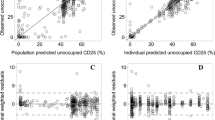Abstract
Background and Objectives
Daclizumab high-yield process (HYP) is a humanized IgG1 monoclonal antibody that binds to the α-subunit (CD25) of the interleukin-2 receptor. The present work characterized the population pharmacokinetics of daclizumab HYP in healthy volunteers (HVs) and subjects with relapsing–remitting multiple sclerosis (RRMS) and evaluated the effects of covariates on daclizumab HYP exposure.
Methods
Measurable serum concentrations (n = 17,139) from 1670 subjects in seven clinical studies (three phase I, one immunogenicity, one phase II with extension, and one phase III) were included in this pharmacokinetic analysis using non-linear mixed–effects modeling. The three phase I studies evaluated single or multiple doses that ranged from 50 to 400 mg with either intravenous or subcutaneous (SC) administration in HVs (n = 71). The phase II with extension studies evaluated doses of 150 or 300 mg SC every 4 weeks (n = 567), and the immunogenicity (n = 113) and the phase III (n = 919) studies evaluated 150 mg SC every 4 weeks, all in RRMS patients.
Results
A two-compartment model with first-order absorption and elimination adequately described daclizumab HYP pharmacokinetics. Clearance (CL) was 0.212 L/day and the central volume of distribution was 3.92 L, scaled by [body weight (kg)/68] with exponents of 0.87 and 1.12, respectively. The peripheral volume of distribution was 2.42 L. Absorption lag time, mean absorption time, and absolute bioavailability (100–300 mg SC) were 1.61 h, 7.2 days, and 88 %, respectively. The daclizumab HYP terminal half-life was 21 days. Baseline CD25, age, and sex did not influence daclizumab HYP pharmacokinetics. Body weight explained 37 and 27 % of the inter-individual variability for CL and central volume of distribution, respectively. Neutralizing antibody (NAb)-positive status (included as a time-varying covariate) increased daclizumab HYP CL by 19 %.
Conclusions
Consistent with previous findings in HVs, this analysis including extensive data from RRMS patients demonstrates that daclizumab HYP is characterized by slow CL, linear pharmacokinetics at doses above 100 mg, and high SC bioavailability. The pharmacokinetics of daclizumab HYP were not influenced by age (range 18–66 years), the sex of adult subjects, or the baseline CD4+CD25+ T cells (target level). The impact of covariates (body weight, NAb) on daclizumab HYP pharmacokinetics is unlikely to be clinically relevant.




Similar content being viewed by others
References
National Multiple Sclerosis Society. Multiple sclerosis: just the facts general information. 2013. http://www.nationalmssociety.org/What-is-MS/Who-Gets-MS. Accessed 15 May 2015.
Noseworthy JH, Lucchinetti C, Rodriguez M, Weinshenker BG. Multiple sclerosis. N Engl J Med. 2000;343(13):938–52. doi:10.1056/NEJM200009283431307.
Malek TR. The biology of interleukin-2. Annu Rev Immunol. 2008;26:453–79. doi:10.1146/annurev.immunol.26.021607.090357.
Waldmann T, Tagaya Y, Bamford R. Interleukin-2, interleukin-15, and their receptors. Int Rev Immunol. 1998;16(3–4):205–26. doi:10.3109/08830189809042995.
Pfender N, Martin R. Daclizumab (anti-CD25) in multiple sclerosis. Exp Neurol. 2014;262 Pt A:44–51. doi:10.1016/j.expneurol.2014.04.015.
Oh J, Calabresi PA. Emerging injectable therapies for multiple sclerosis. Lancet Neurol. 2013;12(11):1115–26. doi:10.1016/S1474-4422(13)70192-3.
Vincenti F, Kirkman R, Light S, Bumgardner G, Pescovitz M, Halloran P, et al. Interleukin-2-receptor blockade with daclizumab to prevent acute rejection in renal transplantation. Daclizumab Triple Therapy Study Group. N Engl J Med. 1998;338(3):161–5. doi:10.1056/NEJM199801153380304.
Iwanowski P, Losy J. Immunological differences between classical phenothypes of multiple sclerosis. J Neurol Sci. 2015;349(1–2):10–4. doi:10.1016/j.jns.2014.12.035.
Gold R, Giovannoni G, Selmaj K, Havrdova E, Montalban X, Radue EW, et al. Daclizumab high-yield process in relapsing-remitting multiple sclerosis (SELECT): a randomised, double-blind, placebo-controlled trial. Lancet. 2013;381(9884):2167–75. doi:10.1016/S0140-6736(12):62190-4.
Kappos L, Wiendl H, Selmaj K, Arnold DL, Havrdova E, Boyko A, et al. Daclizumab HYP versus interferon beta-1a in relapsing multiple sclerosis. N Engl J Med. 2015;373(15):1418–28. doi:10.1056/NEJMoa1501481.
Othman AA, Tran JQ, Tang MT, Dutta S. Population pharmacokinetics of daclizumab high-yield process in healthy volunteers: integrated analysis of intravenous and subcutaneous, single- and multiple-dose administration. Clin Pharmacokinet. 2014;53(10):907–18. doi:10.1007/s40262-014-0159-9.
Giovannoni G, Gold R, Selmaj K, Havrdova E, Montalban X, Radue EW, et al. Daclizumab high-yield process in relapsing-remitting multiple sclerosis (SELECTION): a multicentre, randomised, double-blind extension trial. Lancet Neurol. 2014;13(5):472–81. doi:10.1016/S1474-4422(14)70039-0.
Lindbom L, Ribbing J, Jonsson EN. Perl-speaks-NONMEM (PsN)—a Perl module for NONMEM related programming. Comput Methods Programs Biomed. 2004;75(2):85–94. doi:10.1016/j.cmpb.2003.11.003.
Minocha M, Tran JQ, Sheridan JP, Othman AA. Blockade of the high-affinity interleukin-2 receptors with daclizumab high-yield process: pharmacokinetic/pharmacodynamic analysis of single- and multiple-dose phase I trials. Clin Pharmacokinet. 2016;55(1):121–30. doi:10.1007/s40262-015-0305-z.
Giovannoni G, Mikulskis A, McNeil M, Riester K, Sweetser M, Elkins J, et al. Evaluation of immunogenicity in multiple sclerosis patients continuously treated with daclizumab-HYP during the SELECT and SELECTION clinical trials. Mult Scler J. 2013;19(11):390 [abstract poster (P864)].
Amaravadi L, Mikulskis A, Lucas N, Riester K, Sweetser M, Elkins J. Evaluation of immunogenicity in patients with multiple sclerosis treated with daclizumab HYP [poster]. 67th Annual Meeting of the American Academy of Neurology; 18–25 Apr 2015; Washington, DC.
Anonymous. DAC HYP BLA 2.7.2 Summary of Clinical Pharmacology. Biogen, 2015 (Data on file).
Acknowledgments
We would like to acknowledge Wei Liu and Vineeth Kurnala of Biogen for dataset preparation.
Author information
Authors and Affiliations
Corresponding author
Ethics declarations
Disclosures
The phase I studies that contributed data to this analysis were funded by Facet, which was acquired by AbbVie. All other non-phase I studies presented in this manuscript were funded by Biogen and AbbVie. All authors contributed to the analysis and interpretation of the data, writing, reviewing and approving the manuscript. Dr. Hang and Dr. Nestorov are employees and shareholders of Biogen. Dr. Diao and Dr. Tran are previous employees of Biogen. Dr. Othman is an employee and shareholder of Abbvie. The authors declare no other conflict of interests.
Electronic supplementary material
Below is the link to the electronic supplementary material.
Rights and permissions
About this article
Cite this article
Diao, L., Hang, Y., Othman, A.A. et al. Population Pharmacokinetics of Daclizumab High-Yield Process in Healthy Volunteers and Subjects with Multiple Sclerosis: Analysis of Phase I–III Clinical Trials. Clin Pharmacokinet 55, 943–955 (2016). https://doi.org/10.1007/s40262-016-0366-7
Published:
Issue Date:
DOI: https://doi.org/10.1007/s40262-016-0366-7




